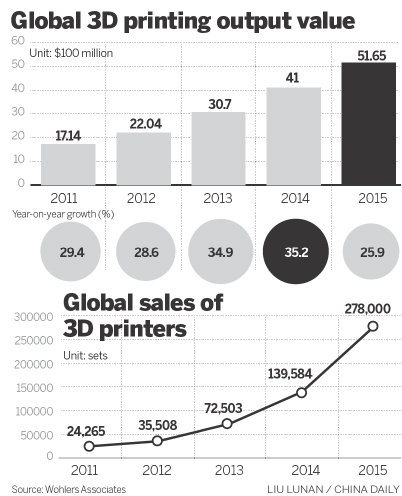Catching up fast in 3D printing
 0 Comment(s)
0 Comment(s) Print
Print E-mail China Daily, July 25, 2016
E-mail China Daily, July 25, 2016
 |
|
Chinese doctors set a new record in a spinal operation to replace five vertebrae with 3D-printed replicas. The 3D-printed vertebrae measured 19 centimeters, the longest ever in a successful operation.[Photo/Xinhua] |
Lin from Tsinghua University said his team is working on developing a 3D printing technology for cell structures. The team started using the technology in the biomedical sector in the early 2000s. In December 2015, it built a model of totipotent stem cell with a survival rate of 95 percent through 3D printing. This development is expected to overcome the problem of cultivating this highly productive but extremely sensitive cell.
"The characteristic of a cell has a lot to do with its shape. If we can imitate the cell and tissue activity in human body, we can research the process of human being and even the process of a disease. Therefore, we can use these research results to select medicines, and even to study the cell of cancer," said Lin.
Patrick Thomas, CEO of Covestro, a supplier of high-tech polymers, views 3D printing as a major opportunity for efficient mass production of complex or individualized parts. But the technology has to clear some hurdles before it can go into more widespread use, he said.
"While over 3,000 materials are available for conventional component manufacturing, only about 30 are available for 3D printing."
Chinese universities and institutions are putting more efforts in 3D printing research and development.
Tsinghua University's team turned their research into real products through cooperation with companies like Beijing Yinhua Laser Rapid Prototypes Making and Mould Technology Co Ltd and Tiertime Technology Co Ltd.
To date, 48.2 percent of the 1,549 Chinese branded industrial 3D printers sold were made by Beijing Tiertime or Beijing Yinhua, according to the latest data from Wohlers Associates.
The Huazhong University of Science and Technology has formed several sector-wise 3D printing R&D teams.
Shi Yusheng, a professor with the university, and his team have sold more than 300 units of their developed 3D facilities and materials to the United Kingdom, Singapore, Brazil and Russia.






Go to Forum >>0 Comment(s)